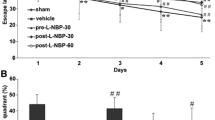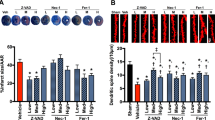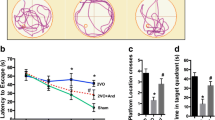Abstract
Long-term memory impairment is reported in more than 50% of cardiac arrest survivors. Monosialoganglioside (GM1) provided neuroprotection in experimental models of stroke but failed to replicate its promise clinically for unknown reasons. GM1 stimulates the release of nerve growth factor (NGF), which is synthesized as a precursor protein (pro-NGF) that either mediates apoptosis through the p75 neurotrophin receptor (p75NTR) or is cleaved by the protease furin (FUR) to yield mature NGF, the latter supporting survival through tropomyosin kinase receptor (Trk). The flavanol epicatechin (EPI) inhibits p75NTR-mediated signaling and apoptosis by pro-NGF. The aim of the current work is to test whether these two drugs affect, or communicate with, each other in the setting of CNS injuries. Using the two-vessel occlusion model of global ischemia/reperfusion (I/R), we tested if pharmacological modulation of Trk, p75NTR, and NGF balance with GM1, EPI, and their combination, can correct the memory deficit that follows this insult. Finally, we tested if FUR insufficiency and/or p75NTR-mediated apoptosis negatively affect the neurotherapeutic effect of GM1. Key proteins for Trk and p75NTR, FUR, and both forms of NGF were assessed. All treatment regiments successfully improved spatial memory retention and acquisition. A week after the insult, most Trk and p75NTR proteins were normal, but pro/mature NGF ratio remained sharply elevated and was associated with the poorest memory performance. Pharmacological correction of this balance was achieved by reinforcing Trk and p75NTR signaling. GM1 increased FUR levels, while concomitant administration of EPI weakened GM1 effect on pro-survival Trk and p75NTR mediators. GM1 neuroprotection is therefore not limited by FUR but could be dependent on p75NTR.

"."






Similar content being viewed by others
Abbreviations
- Akt:
-
Protein kinase B
- Bcl-2:
-
B cell lymphoma-2 protein
- CA:
-
Cardiac arrest
- CT:
-
Cycle threshold
- DMSO:
-
Dimethyl sulfoxide
- EPI:
-
Epicatechin
- FUR:
-
Furin
- GAPDH:
-
Glyceraldehyde-3-phosphate dehydrogenase
- GM1:
-
Monosialoganglioside
- GSK3β:
-
Glycogen synthase kinase 3β
- I/R:
-
Ischemia/reperfusion
- JNK:
-
Jun-kinase
- MCAO:
-
Middle cerebral artery occlusion
- NF- κB:
-
Nuclear factor-κB
- NGF:
-
Nerve growth factor
- NTs:
-
Neurotrophins
- p38MAPK:
-
Mitogen-activated protein kinase
- p75NTR:
-
p75 neurotrophin receptor
- PI3K:
-
Phosphoinositol-3 kinase
- PLC:
-
Phospholipase-C
- PTEN:
-
phosphatase and tensin homolog
- Trk:
-
Tropomyosin kinase receptor
References
Al-Gayyar MM, Matragoon S, Pillai BA, Ali TK, Abdelsaid MA, El-Remessy AB (2011) Epicatechin blocks pro-nerve growth factor (proNGF)-mediated retinal neurodegeneration via inhibition of p75 neurotrophin receptor expression in a rat model of diabetes [corrected]. Diabetologia 54:669–680
Aloe L, Rocco ML, Bianchi P, Manni L (2012) Nerve growth factor: from the early discoveries to the potential clinical use. J Transl Med 10:239
Alter M (1998) GM1 ganglioside for acute ischemic stroke. Trial design issues. Ann N Y Acad Sci 845:391–401
Angelo MF, Aviles-Reyes RX, Villarreal A, Barker P, Reines AG, Ramos AJ (2009) p75 NTR expression is induced in isolated neurons of the penumbra after ischemia by cortical devascularization. J Neurosci Res 87:1892–1903
Atkins CM, Oliva AA Jr, Alonso OF, Pearse DD, Bramlett HM, Dietrich WD (2007) Modulation of the cAMP signaling pathway after traumatic brain injury. Exp Neurol 208:145–158
Beattie MS, Harrington AW, Lee R, Kim JY, Boyce SL, Longo FM, Bresnahan JC, Hempstead BL, Yoon SO (2002) ProNGF induces p75-mediated death of oligodendrocytes following spinal cord injury. Neuron 36:375–386
Brambrink AM, Schneider A, Noga H, Astheimer A, Gotz B, Korner I, Heimann A, Welschof M, Kempski O (2000) Tolerance-inducing dose of 3-nitropropionic acid modulates bcl-2 and bax balance in the rat brain: a potential mechanism of chemical preconditioning. J Cereb Blood Flow Metab 20:1425–1436
Broadbent NJ, Squire LR, Clark RE (2004) Spatial memory, recognition memory, and the hippocampus. Proc Natl Acad Sci U S A 101:14515–14520
Candelise L, Ciccone A (2002) Gangliosides for acute ischemic stroke. Stroke 33:2336
Capsoni S, Brandi R, Arisi I, D'Onofrio M, Cattaneo A (2011) A dual mechanism linking NGF/proNGF imbalance and early inflammation to Alzheimer’s disease neurodegeneration in the AD11 anti-NGF mouse model. CNS Neurol Disord Drug Targets 10:635–647
Carmack SA, Block CL, Howell KK, Anagnostaras SG (2014) Methylphenidate enhances acquisition and retention of spatial memory. Neurosci Lett 567:45–50
Chao MV (2003) Neurotrophins and their receptors: a convergence point for many signalling pathways. Nat Rev Neurosci 4:299–309
Chen T, Wang J, Li C, Zhang W, Zhang L, An L, Pang T, Shi X, Liao H (2014) Nafamostat mesilate attenuates neuronal damage in a rat model of transient focal cerebral ischemia through thrombin inhibition. Sci. Rep 4:5531
Coucha M, Li W, Johnson MH, Fagan SC, Ergul A (2013) Protein nitration impairs the myogenic tone of rat middle cerebral arteries in both ischemic and nonischemic hemispheres after ischemic stroke. Am J Physiol Heart Circ Physiol 305:H1726–H1735
Davies AM (1995) The Bcl-2 family of proteins, and the regulation of neuronal survival. Trends Neurosci 18:355–358
Davies AM, Lee KF, Jaenisch R (1993) p75-deficient trigeminal sensory neurons have an altered response to NGF but not to other neurotrophins. Neuron 11:565–574
De SE, Zazzeroni F, Papa S, Nguyen DU, Jin R, Jones J, Cong R, Franzoso G (2001) Induction of gadd45beta by NF-kappaB downregulates pro-apoptotic JNK signalling. Nature 414:308–313
Deblon N, Bourgoin L, Veyrat-Durebex C, Peyrou M, Vinciguerra M, Caillon A, Maeder C, Fournier M, Montet X, Rohner-Jeanrenaud F, Foti M (2012) Chronic mTOR inhibition by rapamycin induces muscle insulin resistance despite weight loss in rats. Br J Pharmacol 165:2325–2340
Di PA, Maglione V, Alpaugh M, Horkey M, Atwal RS, Sassone J, Ciammola A, Steffan JS, Fouad K, Truant R, Sipione S (2012) Ganglioside GM1 induces phosphorylation of mutant huntingtin and restores normal motor behavior in Huntington disease mice. Proc Natl Acad Sci U S A 109:3528–3533
Fong TG, Neff NH, Hadjiconstantinou M (1997) GM1 ganglioside improves spatial learning and memory of aged rats. Behav Brain Res 85:203–211
Fujioka M, Nishio K, Miyamoto S, Hiramatsu KI, Sakaki T, Okuchi K, Taoka T, Fujioka S (2000) Hippocampal damage in the human brain after cardiac arrest. Cerebrovasc Dis 10:2–7
Goold RG, Gordon-Weeks PR (2003) NGF activates the phosphorylation of MAP1B by GSK3beta through the TrkA receptor and not the p75(NTR) receptor. J Neurochem 87:935–946
Hadjiconstantinou M, Neff NH (1998) GM1 ganglioside: in vivo and in vitro trophic actions on central neurotransmitter systems. J Neurochem:1335–1345
Harrington AW, Kim JY, Yoon SO (2002) Activation of Rac GTPase by p75 is necessary for c-jun N-terminal kinase-mediated apoptosis. J Neurosci 22:156–166
Harrington AW, Leiner B, Blechschmitt C, Arevalo JC, Lee R, Morl K, Meyer M, Hempstead BL, Yoon SO, Giehl KM (2004) Secreted proNGF is a pathophysiological death-inducing ligand after adult CNS injury. Proc Natl Acad Sci U S A 101:6226–6230
Hopkins CR, Gibson A, Shipman M, Miller K (1990) Movement of internalized ligand-receptor complexes along a continuous endosomal reticulum. Nature 346:335–339
Horner PJ, Gage FH (2000) Regenerating the damaged central nervous system. Nature 407:963–970
Irmady K, Jackman KA, Padow VA, Shahani N, Martin LA, Cerchietti L, Unsicker K, Iadecola C, Hempstead BL (2014) Mir-592 regulates the induction and cell death-promoting activity of p75NTR in neuronal ischemic injury. J Neurosci 34:3419–3428
Janis LS, Glasier MM, Stein DG (1997) Effects of a single intraseptal injection of NGF on spatial learning in the water maze. Physiol Behav 62:69–76
Kim S, Domon-Dell C, Kang J, Chung DH, Freund JN, Evers BM (2004) Down-regulation of the tumor suppressor PTEN by the tumor necrosis factor-alpha/nuclear factor-kappaB (NF-kappaB)-inducing kinase/NF-kappaB pathway is linked to a default IkappaB-alpha autoregulatory loop. J Biol Chem 279:4285–4291
Kokaia Z, Andsberg G, Martinez-Serrano A, Lindvall O (1998) Focal cerebral ischemia in rats induces expression of P75 neurotrophin receptor in resistant striatal cholinergic neurons. Neuroscience 84:1113–1125
Langnaese K, John R, Schweizer H, Ebmeyer U, Keilhoff G (2008) Selection of reference genes for quantitative real-time PCR in a rat asphyxial cardiac arrest model. BMC Mol Biol 9:53
Lazzaro A, Seren MS, Koga T, Zanoni R, Schiavo N, Manev H (1994) GM1 reduces infarct volume after focal cerebral ischemia. Exp Neurol 125:278–285
Le AP, Friedman WJ (2012) Matrix metalloproteinase-7 regulates cleavage of pro-nerve growth factor and is neuroprotective following kainic acid-induced seizures. J Neurosci 32:703–712
Ledeen RW (1978) Ganglioside structures and distribution: are they localized at the nerve ending? J Supramol Struct 8:1–17
Lee TH, Kato H, Chen ST, Kogure K, Itoyama Y (1998) Expression of nerve growth factor and trkA after transient focal cerebral ischemia in rats. Stroke 29:1687–1696
Lee R, Kermani P, Teng KK, Hempstead BL (2001) Regulation of cell survival by secreted proneurotrophins. Science 294:1945–1948
Lenzi GL, Grigoletto F, Gent M, Roberts RS, Walker MD, Easton JD, Carolei A, Dorsey FC, Rocca WA, Bruno R (1994) Early treatment of stroke with monosialoganglioside GM-1. Efficacy and safety results of the Early Stroke Trial. Stroke 25:1552–1558
Leon A, Lipartiti M, Seren MS, Lazzaro A, Mazzari S, Koga T, Toffano G, Skaper SD (1990) Hypoxic-ischemic damage and the neuroprotective effects of GM1 ganglioside. Stroke 21:III95–III97
Livak KJ, Schmittgen TD (2001) Analysis of relative gene expression data using real-time quantitative PCR and the 2(−Delta Delta C(T)) Method. Methods 25:402–408
Lu B, Pang PT, Woo NH (2005) The yin and yang of neurotrophin action. Nat Rev Neurosci 6:603–614
Makkerh JP, Ceni C, Auld DS, Vaillancourt F, Dorval G, Barker PA (2005) p75 neurotrophin receptor reduces ligand-induced Trk receptor ubiquitination and delays Trk receptor internalization and degradation. EMBO Rep 6:936–941
Mocchetti I (2005) Exogenous gangliosides, neuronal plasticity and repair, and the neurotrophins. Cell Mol Life Sci 62:2283–2294
Moulaert VR, Verbunt JA, van Heugten CM, Wade DT (2009) Cognitive impairments in survivors of out-of-hospital cardiac arrest: a systematic review. Resuscitation 80:297–305
Mozaffarian D, Benjamin EJ, Go AS, Arnett DK, Blaha MJ, Cushman M, de Ferranti S, Despres JP, Fullerton HJ, Howard VJ, Huffman MD, Judd SE, Kissela BM, Lackland DT, Lichtman JH, Lisabeth LD, Liu S, Mackey RH, Matchar DB, McGuire DK, Mohler ER, III CSM, Muntner P, Mussolino ME, Nasir K, Neumar RW, Nichol G, Palaniappan L, Pandey DK, Reeves MJ, Rodriguez CJ, Sorlie PD, Stein J, Towfighi A, Turan TN, Virani SS, Willey JZ, Woo D, Yeh RW, Turner MB (2015) Heart disease and stroke statistics—2015 update: a report from the American Heart Association. Circulation 131:e29–e322
Nakatomi H, Kuriu T, Okabe S, Yamamoto S, Hatano O, Kawahara N, Tamura A, Kirino T, Nakafuku M (2002) Regeneration of hippocampal pyramidal neurons after ischemic brain injury by recruitment of endogenous neural progenitors. Cell 110:429–441
Pan W, Banks WA, Kastin AJ (1998) Permeability of the blood-brain barrier to neurotrophins. Brain Res 788:87–94
Rabin SJ, Mocchetti I (1995) GM1 ganglioside activates the high-affinity nerve growth factor receptor trkA. J Neurochem 65:347–354
Rabin SJ, Bachis A, Mocchetti I (2002) Gangliosides activate Trk receptors by inducing the release of neurotrophins. J Biol Chem 277:49466–49472
Reichardt LF (2006) Neurotrophin-regulated signalling pathways. Philos Trans R Soc Lond B Biol Sci 361:1545–1564
Roux PP, Barker PA (2002) Neurotrophin signaling through the p75 neurotrophin receptor. Prog Neurobiol 67:203–233
S.a.T.F.o.t.A.H.A. ECC Committee (2005) American Heart Association guidelines for cardiopulmonary resuscitation and emergency cardiovascular care. Circulation 112:IV1–IV203
Sanderson TH, Reynolds CA, Kumar R, Przyklenk K, Huttemann M (2013) Molecular mechanisms of ischemia-reperfusion injury in brain: pivotal role of the mitochondrial membrane potential in reactive oxygen species generation. Mol Neurobiol 47:9–23
Seif el NM, Nuglisch J, Krieglstein J (1992) Prevention of ischemia-induced cerebral hypothermia by controlling the environmental temperature. J Pharmacol Toxicol Methods 27:23–26
Shah ZA, Li RC, Ahmad AS, Kensler TW, Yamamoto M, Biswal S, Dore S (2010) The flavanol (-)-epicatechin prevents stroke damage through the Nrf2/HO1 pathway. J Cereb Blood Flow Metab 30:1951–1961
Soligo M, Protto V, Florenzano F, Bracci-Laudiero L, De Benedetti F, Chiaretti A, Manni L (2015) The mature/pro nerve growth factor ratio is decreased in the brain of diabetic rats: analysis by ELISA methods. Brain Res 1624:455–468
Song W, Volosin M, Cragnolini AB, Hempstead BL, Friedman WJ (2010) ProNGF induces PTEN via p75NTR to suppress Trk-mediated survival signaling in brain neurons. J Neurosci 30:15608–15615
Sorkin A, Waters CM (1993) Endocytosis of growth factor receptors. Bioessays 15:375–382
Takahashi Y, Shimokawa N, Esmaeili-Mahani S, Morita A, Masuda H, Iwasaki T, Tamura J, Haglund K, Koibuchi N (2011) Ligand-induced downregulation of TrkA is partly regulated through ubiquitination by Cbl. FEBS Lett 585:1741–1747
Teng KK, Hempstead BL (2004) Neurotrophins and their receptors: signaling trios in complex biological systems. Cell Mol Life Sci 61:35–48
Teng KK, Felice S, Kim T, Hempstead BL (2010) Understanding proneurotrophin actions: recent advances and challenges. Dev Neurobiol 70:350–359
Tiveron C, Fasulo L, Capsoni S, Malerba F, Marinelli S, Paoletti F, Piccinin S, Scardigli R, Amato G, Brandi R, Capelli P, D'Aguanno S, Florenzano F, La Regina F, Lecci A, Manca A, Meli G, Pistillo L, Berretta N, Nistico R, Pavone F, Cattaneo A (2013) ProNGF\NGF imbalance triggers learning and memory deficits, neurodegeneration and spontaneous epileptic-like discharges in transgenic mice. Cell Death Differ 20:1017–1030
Ulrich PT, Kroppenstedt S, Heimann A, Kempski O (1998) Laser-Doppler scanning of local cerebral blood flow and reserve capacity and testing of motor and memory functions in a chronic 2-vessel occlusion model in rats. Stroke 29:2412–2420
van Praaq H, Lucero MJ, Yeo GW, Stecker K, Heivand N, Zhao C, Yip E, Afanador M, Schroeter H, Hammerstone J, Gage FH (2007) Plant-derived flavanol (−)epicatechin enhances angiogenesis and retention of spatial memory in mice. J Neurosci 27:5869–5878
Wadowska M, Woods J, Rogozinska M, Briones TL (2015) Neuroprotective effects of enriched environment housing after transient global cerebral ischaemia are associated with the upregulation of insulin-like growth factor-1 signalling. Neuropathol Appl Neurobiol 41:544–556
Waterman H, Yarden Y (2001) Molecular mechanisms underlying endocytosis and sorting of ErbB receptor tyrosine kinases. FEBS Lett 490:142–152
Weber M, Mohand-Said S, Hicks D, Dreyfus H, Sahel JA (1996) Monosialoganglioside GM1 reduces ischemia--reperfusion-induced injury in the rat retina. Invest Ophthalmol Vis Sci 37:267–273
Woodruff TM, Thundyil J, Tang SC, Sobey CG, Taylor SM, Arumugam TV (2011) Pathophysiology, treatment, and animal and cellular models of human ischemic stroke. Mol Neurodegener 6:11
Wu C, Fujihara H, Yao J, Qi S, Li H, Shimoji K, Baba H (2003) Different expression patterns of Bcl-2, Bcl-xl, and Bax proteins after sublethal forebrain ischemia in C57Black/Crj6 mouse striatum. Stroke 34:1803–1808
Xu R, Zhou Y, Fang X, Lu Y, Li J, Zhang J, Deng X, Li S (2014) The possible mechanism of Parkinson’s disease progressive damage and the preventive effect of GM1 in the rat model induced by 6-hydroxydopamine. Brain Res 1592:73–81
Yoon SO, Casaccia-Bonnefil P, Carter B, Chao MV (1998) Competitive signaling between TrkA and p75 nerve growth factor receptors determines cell survival. J Neurosci 18:3273–3281
Yu C, Minemoto Y, Zhang J, Liu J, Tang F, Bui TN, Xiang J, Lin A (2004) JNK suppresses apoptosis via phosphorylation of the proapoptotic Bcl-2 family protein BAD. Mol Cell 13:329–340
Author information
Authors and Affiliations
Contributions
A.M.C. conceived the study. A.M.C. and H.S.E. jointly designed the experiments. A.M.C. performed the experiments. A.S.A. designed and supervised RT-PCR experiments. A.M.C. and A.S.A. jointly quantified and analyzed gene expression. A.M.C. and M.Y.A. isolated and preserved hippocampal tissue samples. A.M.C., M.Y.A., and H.S.E. performed the statistical analysis. A.M.C. and H.S.E. interpreted the data and wrote the article. M.Y.A. and A.S.A. provided technical support and reviewed the manuscript.
Corresponding author
Ethics declarations
Conflict of Interest
The authors declare that they have no conflict of interest.
Additional information
Publisher’s Note
Springer Nature remains neutral with regard to jurisdictional claims in published maps and institutional affiliations.
Rights and permissions
About this article
Cite this article
Choucry, A.M., Al-Shorbagy, M.Y., Attia, A.S. et al. Pharmacological Manipulation of Trk, p75NTR, and NGF Balance Restores Memory Deficit in Global Ischemia/Reperfusion Model in Rats. J Mol Neurosci 68, 78–90 (2019). https://doi.org/10.1007/s12031-019-01284-1
Received:
Accepted:
Published:
Issue Date:
DOI: https://doi.org/10.1007/s12031-019-01284-1




